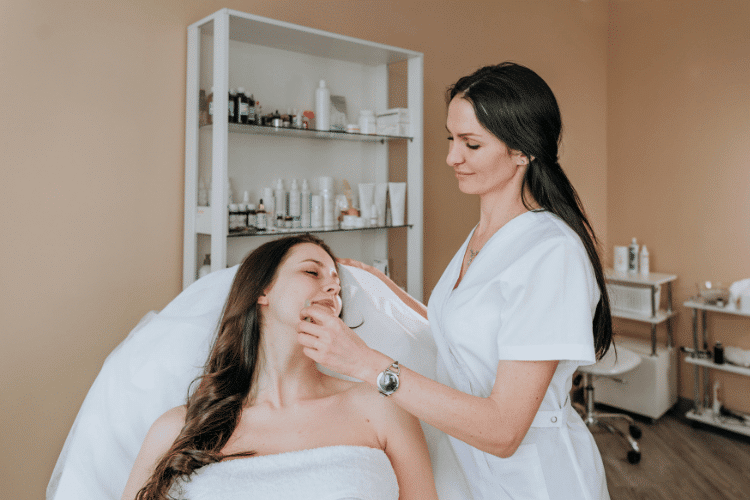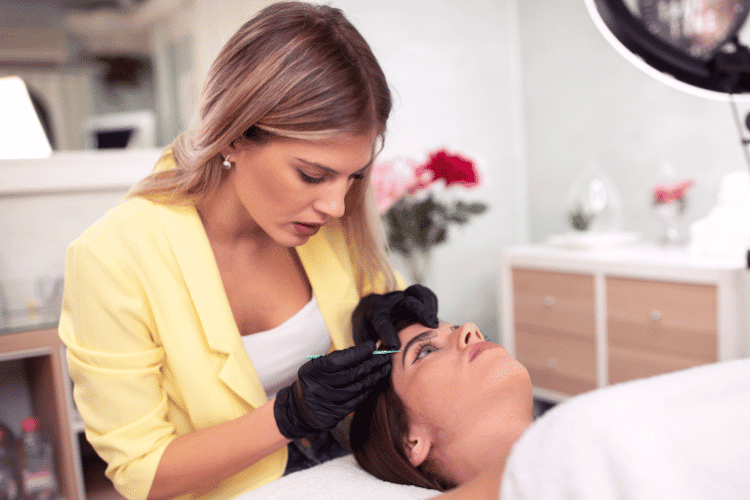Interested in a career related to beauty and skincare but you’re unsure where to start?
Well, we’re glad to report that you’re not alone! We created this handy guide for people wondering how to become an esthetician.
Luckily, the journey toward this career isn’t impossible—far from it, in fact!
The first step is always the hardest, but this tutorial is here to help you prepare and understand the steps to becoming a trained beauty and skincare technician.
An Overview of Esthetician: A Primer
Estheticians, or aestheticians, are professionals who specialize in beauty. They’re also called skin care specialists because most offer services related to skin treatment, such as facials and anti-acne regimes.
They can do skin analysis to determine your skin type and then provide treatments like peels, masks, and body scrubs.
All therapies offered by estheticians are typically only on the outermost or superficial layer of the skin.
It’s important to understand that while one can work as part of some clinics as a paramedical esthetician, this isn’t a medical profession. They focus on cosmetic treatments, not medicating skin conditions and other illnesses.
How Much Do Estheticians Make?
According to the Bureau of Labor Statistics (BLS), the median pay for skin care specialists is $17.93 per hour for around $37,300 per year. Since part-time work is common for estheticians, this number can shift depending on how many clients avail of their services.
Based on the same data source, the highest-paying industries for this type of career are those under other amusement and recreation industries. Skincare specialists in that industry earn an annual mean wage of $53,280.
What You’ll Need to Become an Esthetician & Associated Costs

As with any career, you’ll need to prepare a few requirements to get started. Below is a brief list of the most important prerequisites and an estimate of how much you should expect to spend on each one.
- High School Diploma or GED: A high school diploma or GED is one of the first requirements for most esthetics programs. Obtaining a high school diploma through online classes can cost anywhere between $1,500 to $5,000, while online GED exams cost $36 per subject.
- Education and Training: Completing a cosmetology or esthetician training and vocational program is undoubtedly one of the most important steps in this career path. The average cost of these programs can range from $3,000 to $10,000.
- State License: A license allows you to practice and work as an esthetician. Specific requirements may vary from state to state, but most licensure exams involve written and practical tests that cost roughly $100.
- Experience: Most clients will opt for an esthetician with experience in the field. That said, you may first need to offer services to test clients.
- Customer-service Skill: Your professional relationship with your clients will dictate if they’ll use your service again. You need strong customer service skills to maintain loyalty and rapport among your clientele.
- Other Soft Skills: Other soft skills include time management and organizational skills. As an esthetician, you need to know how to manage your time well to accommodate clients.
How Much Does It Cost to Become an Esthetician?
You’ll need anywhere between $3,500 to $11,000 to become an esthetician. However, this number can go lower or higher depending on your location, esthetics program or school, and esthetician training course requirements.
The bulk of the expenses are from your chosen program. Still, many factors, like textbooks and treatment equipment, can also contribute to the costs.
Is It Hard to Become an Esthetician?
While requirements don’t seem extensive initially, becoming an esthetician right after your education can be challenging for many fresh program graduates.
Clients will usually trust those with experience and might not be open to newer estheticians. This means you might take a while to start growing a loyal clientele.
The good news is, according to the BLS, the employment rate of skin care specialists is expected to grow 17% in the next few years until 2031.
How Long Does It Take to Become an Esthetician?
This heavily depends on the length of the esthetician program and the school you enroll in. According to Indeed, most take roughly 5-6 months to finish their chosen curriculum.
In addition to finishing your coursework, some states require a specified number of relevant work experience or training hours. You have to fulfill these hours before trying to obtain a license.
Most aspiring estheticians take around 260 to over 1,000 hours to become certified skin care specialists. This can also take much longer if you’re not a full-time student or getting work experience hours from part-time shifts.
How to Become an Esthetician in 5 Simple Steps

So, where do you start? Here’s a step-by-step guide that outlines your journey:
Step 1: Find Out if You Need a Diploma or GED
Since the requirements for each esthetician program and beauty school vary per state, the first thing you should do is to find out if you need a high school diploma or GED to enroll. Some programs require one or the other, while some don’t require any.
Either way, having one at the ready opens up more opportunities for you as an aspiring esthetician, as it gives you a wider pool of choices for esthetician programs.
Step 2: Enroll in an Esthetician Program or Cosmetology School
An esthetician school is your primary resource when it comes to learning treatments and techniques as an esthetician. Apart from experience in the field, this is where most of your education will come from.
Aside from forms of skincare treatment, these programs teach students the art of makeup application, aromatherapy, and hair removal procedures, among others.
To become a licensed esthetician, you need to finish your coursework and graduate from your chosen program.
It’s also worth noting that there are some states, like California and New Hampshire, that allow aspiring estheticians to pursue an apprenticeship instead of a formal program.
That said, you may be required to secure a work permit first to participate in an apprenticeship.
Step 3: Earn a License
After finishing your esthetician program, the next step is to obtain a license.
Esthetician licensure exams vary from state to state, but most states use exams from the National-Interstate Council of State Boards of Cosmetology (NIC).
These tests typically involve two parts: a written exam and a practical part. Written exams are similar to standardized ones you take in school, and practical exams may test your skills in fulfilling treatments or situational scenarios and questions.
Licensed estheticians have more opportunities available to them in the field.
Step 4: Increase Experience
After securing a license, you need to start increasing your experience. This will help you hone your skills, open yourself up to various clients, and get a feel for what the real field of work is like.
Being an esthetician is a great second job while you’re starting out. You might offer services at a lower rate when you first enter the field, so it’s good to have other sources of income at this point.
Gradually, as you start to gain more experience, you can attract more clients, develop better skills, and ultimately, charge more for your services.
Step 5: Strive for Certification
One of the pros of becoming an esthetician is you can opt to make this career path a gig-based income job if you want to. However, you can also take your license one step further and aim for certification.
Typically, you’d need at least a few years of experience working as an esthetician before you can consider applying for certification. Having one can increase your chances of getting better pay and more opportunities.
There are many certification options per state, but the most widely known is the National Coalition of Estheticians Association (NCEA)’s National Esthetician Certification.
Reasons to Consider Becoming an Esthetician

More and more industries are opening up to welcome this career path—think medical clinics and even casinos with spas!
Below are four reasons why an esthetician might be better than a full-time position anywhere else.
- Independence: You can choose to open up your own spa or salon. You also have the freedom to offer services to as many or as few clients as you’d like.
- Rewarding: This career is rewarding, and we don’t only mean financially! As an esthetician, you can help people build their confidence.
- Flexibility: Unlike a job that requires late nights of work, becoming an esthetician gives you a lot of flexibility when it comes to how much you want to work, especially if you have your own clientele and aren’t employed under other spas or salons.
- Quicker Path to Employment: Compared to other programs, those in cosmetology school can finish their coursework in five to six months—possibly even faster for full-time students. This means estheticians can begin working and earning earlier.
Frequently Asked Questions
What is the highest-paid medical esthetician?
According to Indeed, Indianapolis, Indiana, is the number one city with the highest-paid medical estheticians because it’s home to many spas and salons. The yearly salary for estheticians in this city can reach over $40,000.
What is the best certification for estheticians?
The National Esthetician Certification is the highest voluntary certification available for estheticians in the US.
This certificate is issued by the national accrediting commission, the National Coalition of Estheticians Association (NCEA), to successful passers of the national exam.
Similar Gigs to Check Out
Here are some other options you can explore if you feel like an esthetician isn’t the right fit for you.
- How to Become a Massage Therapist: Massage therapists are all about relaxation by manipulating soft tissues.
- How to Become a Dietitian: Dietitians are masters of food and nutrition—they recommend diet plans for reaching weight goals in a healthy way!
- How to Become a Nail Tech: People might assume that being an esthetician is a fairly uncommon side hustle because of the course requirements, but it can actually open up many other gigs, like becoming a nail technician!
Wrapping Up
That wraps up our guide on how to become an esthetician.
Pursuing this career path might seem scary at first—committing to hundreds of hours is no joke, after all—but you have to trust the process. The journey and the finish line are worthwhile.
Have anything else to add? Don’t hesitate to share your thoughts, insights, and manifestations in the comments.
If you found this tutorial helpful, consider sharing it with fellow aspiring estheticians!






